![]()
![]()
![]()
Use LEFT and RIGHT arrow keys to navigate between flashcards;
Use UP and DOWN arrow keys to flip the card;
H to show hint;
A reads text to speech;
49 Cards in this Set
- Front
- Back
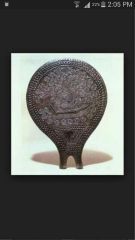
|
"Frying Pan"
-Cycladic -Molded from terichotta clay. -We think this is a boat, water spirals and ores on a boat. -The pubic triangle implies that the sea is the mother of the land. |
|
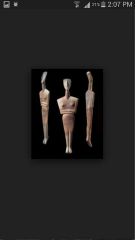
|
Cycladic Figure
-Cycladic -Females were shown flattened. -Simplified geometric forms. -Made of white marble. |
|
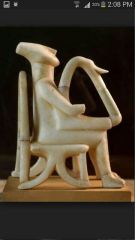
|
Harpist
-Cycladic -More rounded, unlike females. -Shows life and movement. -These "idols" wpuld have been valuable and traded. |
|
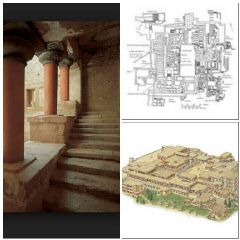
|
Plan, Reconstruction and staircase of the Palace of Minos at Knossos
-Minoan -First civilization with flush toilets. -Confusing palace plan. -This palace was not fortified. |
|
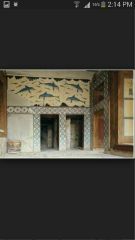
|
The "Queen's Megaron" from Knossos
-Minoan -Example of buon fresco. -A megaron is a big room. -This was basically the queen's apartment, which was part of the palace complex. |
|
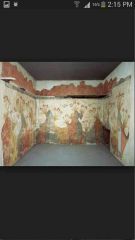
|
Spring Fresco
-Minoan -Example of buon fresco. -All earth pigments. -A lot of landscape was used, which indicates their love for nature. |
|
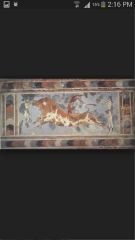
|
Toreador fresco
-Minoan -Like in Egypt, males are shown extremely tan and females are shown extremely pale. -It is believed that the scene depicts a ritual with bull-leaping performances. -The three figures may have represented the same person leaping over the bull. |
|
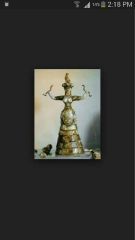
|
Snake Goddess
-Minoan -An indication of power. -Snakes may represent resurrection because they shed their skin. -This would be some type of deity/mother goddess. |
|
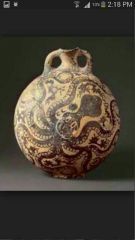
|
Octopus Vase
-Minoan -These types of vases were used as a type of currency and were found in Egyptian tombs. -The painting's forms express the shape of the vessel they decorate. -It's extraordinary dynamic and naturalistic qualities energize the painting. |
|

|
Bull Rhyton
-Minoan -Liquid goes in the back of the head and out of the mouth. -The eyes were inlaid with rock crystal. -The horns were inlaid with gold. |
|
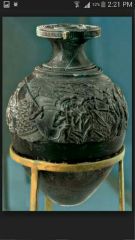
|
Harvester Vase
-Minoan -These smiles are unique because we have yet to see this from other cultures. -Probably would have been used to hold some type of oil. -The certain meaning is unknown, but they may have been harvesters. |
|
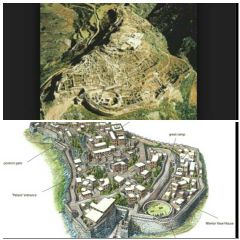
|
Mycenae
-Mycenean -Had really thick fortification walls. -The Mycenean's main focus was on war. -Mycenean citadel and palaces may have incorporated royal residences. |
|
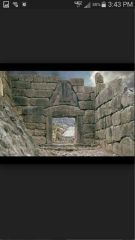
|
The Lioness Gate
-Mycenean -Considered the main entrance to the citadel. -Example of corbel and post-lentil architecture. -The lion heads are missing. They may have been made of another stone or gold. |
|
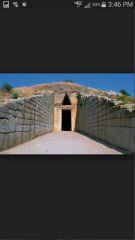
|
Treasury of Atreus
-Mycenean -The relieving triangle is meant to take some of the weight off of the entrance. -The architecture is similar to Egyptian architecture. -The largest open interior space to this time. |
|
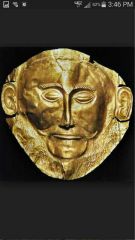
|
"Mask of Agamemnon"
-Mycenean -Despite its title, this was not the actual mask of Agamemnon. -Many historians think this is a fake because it is so different from the others found. -It was thought that the Myceneans obtained their gold from Egypt. |
|
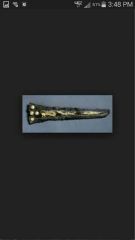
|
Inlaid Dagger Blade
-Mycenean -Made of bronze. -Animals are drawn straighter by Mycenean unlike the curvature shown by Minoan. -The dagger's owner would claim the lion's predatory strength. |
|
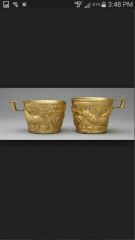
|
Vapheio cups
-Mycenean -These were grave goods. -Used repousse technique. -Both cups show the scene of capturing bulls. |
|

|
Dipylon Vase
-Archaic Greek -This is an example of a geometric period vase. -This was used as a grave marker. -There was a hole in the bottom of the vessel so that you could pour an offering liquid to the deceased. |
|
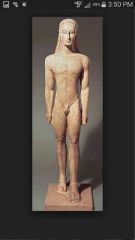
|
The New York Kouros
-Archaic Greek -This would have been plastered over and painted. -Archaic smile is shown. -The Greeks aimed to make their sculptures appear as life-like as possible. |
|
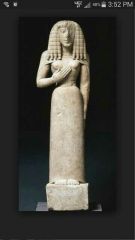
|
Kore
-Archaic Greek -Unlike the Egyptians, the Greek's sculptures are truly free-standing. -Only the wealthy could afford these types of sculptures. -Like the Egyptians, these figures are "rigidly frontal." |
|
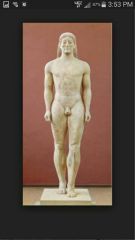
|
Kroisos
-Archaic Greek -The more stylized these figures were, the earlier it would have been made. -Bulging eyes were a common aspect of Archaic Greeks. The slight curve of the lips became known as "the Archaic smile." -The evolution of these figures shows that artists were aiming to show each piece as natural as possible. |
|
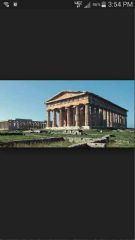
|
The Temple of Hera I and Hera II
-Archaic Greek -The Greeks felt the temples were the homes of the god or goddess. -In the center there would have been a giant sculpture of the god or goddess what lived there. -Most of the rituals occurred in front of the temple rather than in it because it was the god/goddess' home. |
|

|
Kritios Boy
- Classical Greek -Contrapposto (weight-shift) is shown. -This is a representation of a transition from archaic style to classical style. -The bulging eyes and "archaic smile" are no longer shown. |
|
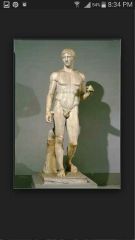
|
Doryphoros
-Classical Greek -Original artist: Polykleitos -Polykleitos was known for his "perfect" proportions. -Polykleitos understood the harmony of flexed vs relaxed body parts. |
|
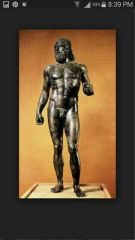
|
Riace Warrior
-Classical Greek -Example of "Severe Style" -Bronze -Who the figure represents is still unknown. |
|
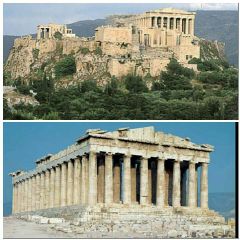
|
The Parthenon
-Classical Greek -"the most measured building in the world." -The Parthenon was dedicated to "Athena Parthenos" -Exterior is Doric style. interior is ionic style. |
|
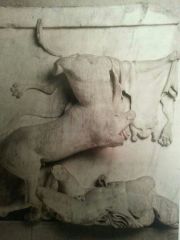
|
Lapith and Centaur
-Classical Greek -Example of a deep relief sculpture. -Made of marble -56" tall |
|
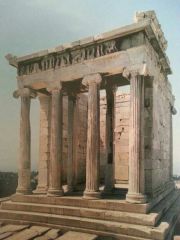
|
Temple of Athena Nike
-Classical Greek -Example of an ionic structure. -Nike means victorious -It may have been designed 20 years earlier than it was built to celebrate the Athenian victory over the Persians. |
|
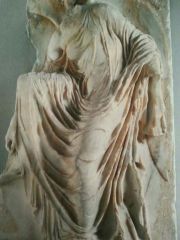
|
Nike
-Classical Greek -Example of wet drapery. -She is taking off her sandals, indicating that she is about to step onto holy ground. -Her wings keep her stable, so that she performs this normally awkward act with elegance and ease. |
|
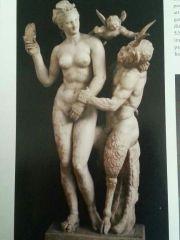
|
Aphrodite, Pan and Eros
-Hellenistic Greek -Found in a gentleman's club. -Shows an extreme of character. -Aphrodite's body is shown less perfect and more realistic. |
|

|
Drunken Old Woman
-Hellenistic Greek -Extremes of age, emotion and motion are shown in this culture to make artists stand out. -wet drapery example -She wears a buckled tunic, which identifies her as a member of an affluent social class. |
|
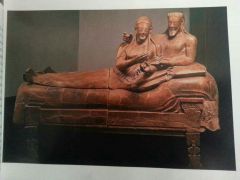
|
Sarcophagus
-Etruscan -This is a coffin. This man and woman were presumably married. -Both figures once held objects in their hands. |
|
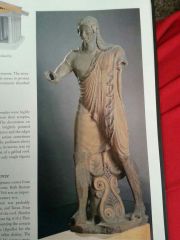
|
Vulca of Veii
-Etruscan -We believe that this is a sculpture of Aplu (Apollo) -The sculptor was Vulca of Veii -This sculpture was made using clay. This uses an additive technique rather than a subtractive. |
|
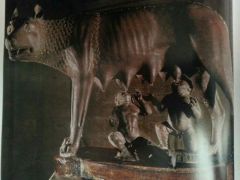
|
She-Wolf of the Capitol
-Etruscan -Made of bronze. -Her body is tensed and protecting while her face shows her fear. -This sculpture has both stylized and smooth lines. |
|
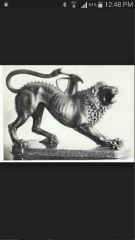
|
Chimera
-Etruscan -Lion's body, serpent's tail, and a goat's head as an appendage. -Made of bronze. -Modern artists have recreated this image. |
|
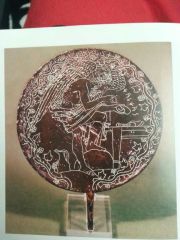
|
Engraved Mirror Back
-Etruscan -Shows how Etruscan adopted Greek traditions to their own end. -This man is gazing intently at the liver of a sacrificial animal, searching for omens. -The E truscans believe that by doing this they cpuld determine if the gods approve of their actions. |
|
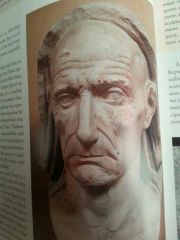
|
Veristic Male Portrait
-Roman -Artists plate up distinguishing marks of the face rather than smoothing over them. -Veristic means "true." Veristic style is realistic. -The remnants of a veil suggests that the subject here was a priest. |
|
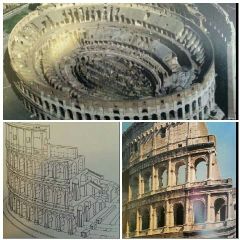
|
The Colosseum
-Roman -Vespasian was the architect, but died before he finished the Colosseum. -held over 50,000 spectators. -Romans were seated according to social rank. |
|
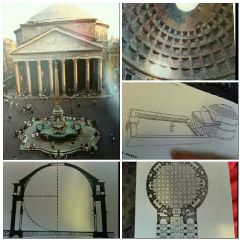
|
The Pantheon
-Roman -original architect: Agrippa -The name suggests that he built the Pantheon as a temple to all the gods. -The first two constructions were destroyed by fire and lightning. |
|

|
Ara Pacis Augustae
-Roman -This stood inside a marble enclosure. -On the east and west side there are relief sculptures that show figures from Rome's legendary past. -On the north and south sides the upper registers show figures from the imperial family. |
|

|
Arch of Titus
-Roman -The earliest surviving free-standing arch in Rome. -Titus was the son and successor of Vispasian. -The arch may have celebrated triumph or it may have been a monument for the death of Titus. |
|
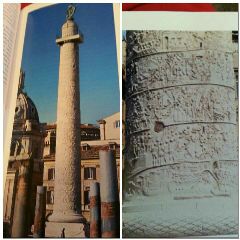
|
Column of Trajan
-Roman -A stair case circled up the interior so a visitor could look out over Trajan's extraordinary building complex. -This is a 656 ft long continuous narrative relief. -Because the column is so tall it is difficult for the naked eye to follow the narrative. |
|
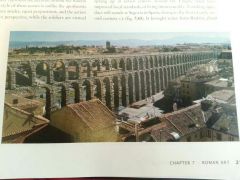
|
Pont du Gard aqueduct
-Roman -Made of granite. -Most of the aqueduct flowed beneath the ground. -Architects also built this massive bridge as part of the water channel. |
|
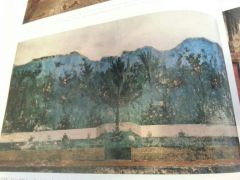
|
Walled Garden
-Roman -Plants and animals become less distinct as they recede into the background. -Artists created paintings that would make the viewer want to explore further into the painting. -This painting is an idyll of nature. |
|
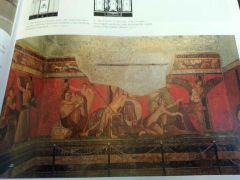
|
painting from the Villa of the Mysteries
-Roman -Artists employed architectural vistas to open the wall into a fantasy realm. -This may have been the architectural backdrop in theaters. -With this type of painting the structures size and spatial relationships are hard to determine. |
|
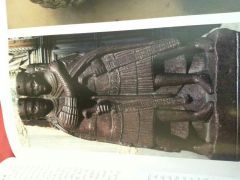
|
Tetrarchs
-Roman -These were probably originally mounted in columns. -The proportions are nonnaturalistic. -The similarities shown underlines the tetrarchs equality. |
|
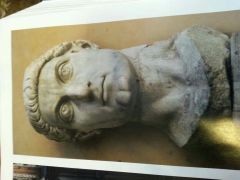
|
Head of Constantine
-Roman -The eyes are disproportionately large and deeply carved. -This piece has an ionic quality. -Some scholars think the eyes may be gazing at something beyond this world. |
|
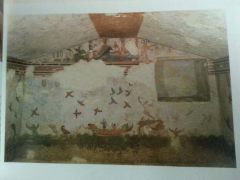
|
Tomb of Hunting and Fishing
-Etruscan -Buon fresco example. -These tombs would have shown images that the person/people liked. In this case it was hunting and fishing. -There is a large sense of movement portrayed. |
|
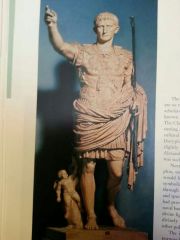
|
Augustus of Primaporta
-Roman -Augustus became emperor when he was no more than 36 years old. -This statue was found in the home of the emperor's wife. -His portrait seems to combine a series of references to previous works of art and historical events. |

